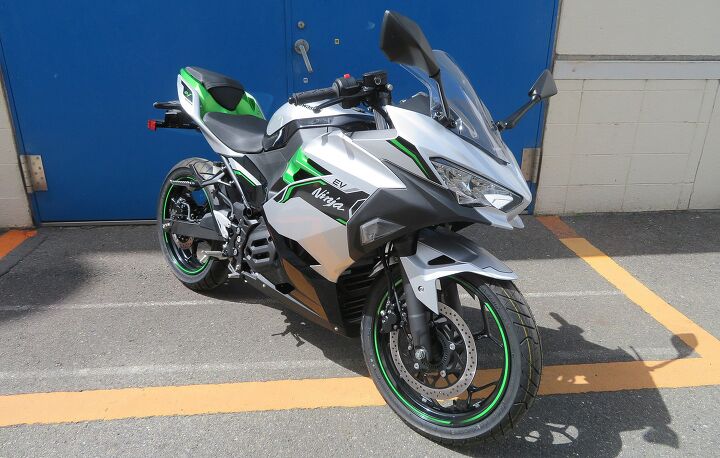Key Points
- Kawasaki has submitted homologation data for its upcoming electric Ninja and Z models.
- The models will be marketed as the Ninja e-1 and Z e-1.
- The models share the same bodywork as their respective gas-powered 400 models.
- The e-1 models will be powered by 11 kW (14.8 hp) motors.
- The models have a wheelbase of 53.9 inches.
- Kawasaki certified a tare weight of 135 kg (298 pounds) for the Z e-1 and 140 kg (309 pounds) for the Ninja e-1.
- The models are expected to be the first in a range of alternative fuel products Kawasaki has in the works.
Kawasaki is gearing up to launch its first electric street bikes, the Ninja e-1 and Z e-1. These models were showcased as prototypes at EICMA and will now be officially launched with some minor updates. The homologation filings in Australia provide some interesting details about the bikes.

Ninja e-1 and Z e-1
Both the Ninja e-1 and Z e-1 will feature the same bodywork as their gas-powered counterparts, the Ninja 400 and Z400, respectively. However, they will be lower-powered and comply with the European A1 license requirements.
The electric bikes will be equipped with 11 kW (14.8 hp) motors, although the homologation documents indicate a slightly lower net engine power of 9.0 kW (12.1 hp), which might be due to the distinction between peak and sustained power output.
The wheelbase for both models will be 53.9 inches, similar to the Z400 and Ninja 400. The tare weight (mass without fuel) is listed as 135 kg (298 pounds) for the Z e-1 and 140 kg (309 pounds) for the Ninja e-1. However, it’s not clear whether this includes the batteries.
Battery packs
The electric bikes are said to be powered by two removable battery packs, each weighing about 12 kg, with a combined capacity of 3.0 kWh. If the tare weight does not include the batteries, the curb weight is estimated to be around 350 pounds for the Z e-1 and 362 pounds for the Ninja e-1.
Kawasaki has further plans to expand its alternative fuel product range. They have announced the intention to release a hybrid model as part of their 2024 model range, and they are also working on a hydrogen-powered model. The naming scheme, “e-1,” suggests that more powerful “e-2” models might be introduced in the future.

Electric Mobility
With the increasing interest in electric mobility, it’s exciting to see major motorcycle manufacturers like Kawasaki taking steps toward electrification and exploring various alternative fuel options. The launch of the Ninja e-1 and Z e-1 will undoubtedly generate a lot of curiosity and anticipation among motorcycle enthusiasts.
Sure, here are some pros and cons of electric motorcycles like the Kawasaki Ninja e-1 and Z e-1:
Pros:
- Environmentally Friendly: Electric motorcycles produce zero tailpipe emissions, which helps reduce air pollution and greenhouse gas emissions, contributing to cleaner air and a healthier environment.
- Quiet Operation: Electric bikes are much quieter compared to their gas-powered counterparts, reducing noise pollution in urban areas and making for a more peaceful riding experience.
- Low Operating Costs: Electricity is generally cheaper than gasoline, and electric motorcycles have fewer moving parts, leading to reduced maintenance costs over time.
- Instant Torque: They deliver instant torque, providing quick and responsive acceleration, making them fun and exhilarating to ride.
- Regenerative Braking: Many electric motorcycles have regenerative braking systems, which help recharge the batteries during deceleration, improving overall energy efficiency.
- Simplified Gearbox: Electric bikes typically have a single-speed transmission, eliminating the need for gear shifting, making them easier to ride, especially for beginners.
- Reduced Vibration: Electric motorcycles have fewer vibrations compared to internal combustion engine bikes, leading to a smoother and more comfortable ride.
Cons:
- Limited Range: The range of electric motorcycles is still somewhat limited compared to gas-powered bikes. Although it’s improving with advancements in battery technology, long-distance travel may require careful planning and charging stops.
- Charging Infrastructure: The availability of charging stations is not as widespread as gas stations, making long trips in remote areas more challenging.
- Long Charging Times: Charging an electric motorcycle can take significantly longer than refuelling a gas bike, especially with standard charging options.
- Higher Upfront Cost: Electric motorcycles tend to have higher upfront costs due to the expensive battery technology, though this gap is gradually narrowing.
- Weight and Size: Batteries are relatively heavy, and this can affect the overall weight and handling of the motorcycle.
- Limited Model Selection: While the market for electric motorcycles is growing, the selection of models and brands may still be more limited compared to traditional gas-powered motorcycles.
- Dependence on Electricity: Electric motorcycles rely entirely on electricity, so if there’s a power outage or grid failure, charging can become problematic.
Conclusion
Electric motorcycles offer numerous advantages in terms of environmental impact, reduced operating costs, and enjoyable riding experiences. However, the limited range and charging infrastructure are still challenges to overcome. As battery technology improves and charging infrastructure expands, electric motorcycles are likely to become even more popular and practical options for riders.

































